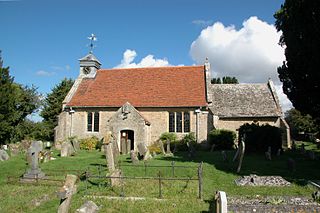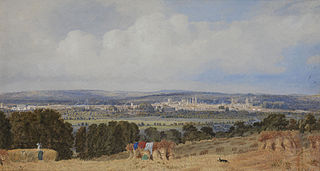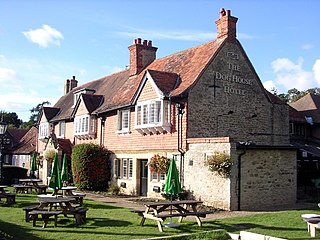
Wantage is a historic market town and civil parish in the Vale of White Horse, Oxfordshire, England. Although within the boundaries of the historic county of Berkshire, it has been administered as part of Oxfordshire since 1974. The town is on Letcombe Brook, 8 miles (13 km) south-west of Abingdon, 24 miles (39 km) north-west of Reading, 15 miles (24 km) south-west of Oxford and 14 miles (23 km) north-west of Newbury.

Grove is a village and civil parish in Oxfordshire, England. It was part of Berkshire until it was transferred in the 1974 boundary changes.

Botley is a village in the civil parish of Botley and North Hinksey, in the Vale of White Horse district, in the county of Oxfordshire, England, just west of the Oxford city boundary. Historically part of Berkshire, it stands on the Seacourt Stream, a stream running off the River Thames. The intersection of the A34 and A420 is to the village's north.

North Hinksey is a village in the civil parish of Botley and North Hinksey, in the Vale of White Horse district, in Oxfordshire, England, on the west side of the Thames flood plain immediately opposite the city of Oxford. The civil parish includes the large settlement of Botley, effectively an isolated suburb of Oxford, with the Botley Road as the sole highway link across the flood plain. North Hinksey was in all respects part of Berkshire until the 1974 boundary changes transferred administration of the Vale of White Horse district to Oxfordshire County Council; it remains part of the historic county of Berkshire however, since the 1974 act did not change the ancient county boundaries. The village of North Hinksey has a manor house, The Fishes public house, a Church of England primary school and a Church of England parish church, St. Lawrence's, which dates back to at least the 12th century. Four of the older houses have thatched roofs.

Oxford West and Abingdon is a constituency represented in the House of Commons of the UK Parliament since 2017 by Layla Moran, a Liberal Democrat.
Abingdon was a rural district in the administrative county of Berkshire from 1894 to 1974.

South Hinksey is a village and civil parish just over 1 mile (1.6 km) south of the centre of Oxford. The parish includes the residential area of Hinksey Hill about 0.5 miles (800 m) south of the village. The parish was part of Berkshire until the 1974 boundary changes transferred it to Oxfordshire.

Southmoor is a village in the civil parish of Kingston Bagpuize with Southmoor, about 6 miles (9.7 km) west of Abingdon, Oxfordshire. Historically part of Berkshire, the 1974 boundary changes transferred local government to Oxfordshire. Southmoor village is just south of the A420 between Oxford and Swindon.

Wootton is a village and civil parish in the Vale of White Horse about 3 miles (5 km) north-west of Abingdon. It was part of Berkshire until the 1974 boundary changes transferred it to Oxfordshire. The parish of Wootton includes the hamlets of Whitecross and Lamborough Hill and the western part of Boars Hill. The 2011 Census recorded the parish's population as 2,709.
Harcourt Hill is a hill and community in North Hinksey in Oxfordshire, England, west of the city of Oxford. There is a good view of the city from the hill. It lies between Hinksey Hill to the southeast, Boars Hill to the south and Botley to the north. Until 1974 it was in Berkshire, but was transferred to Oxfordshire in that year.

Hinksey Hill is a hill and residential area 2 miles (3.2 km) south of the centre of Oxford. It is in South Hinksey civil parish, about 0.5 miles (800 m) south of the village. Hinksey Hill was part of Berkshire until the 1974 boundary changes transferred it to Oxfordshire.

Seacourt is a deserted medieval village (DMV) in the civil parish of Wytham, in the Vale of White Horse district, in Oxfordshire, England, near the city of Oxford. The site is now mostly beneath the Oxford Western By-pass (A34), about 0.3 miles (0.48 km) south of the Seacourt/Hinksey Stream crossing.

Frilford is a hamlet and civil parish in the Vale of White Horse district of Oxfordshire, England. It is about 3 miles (4.8 km) west of Abingdon at the junction of the A415 and A338 roads. It was part of Berkshire until it transferred to Oxfordshire in the 1974 boundary changes.

Chilswell is a small settlement in the parish of Cumnor, Oxfordshire. It lies between the village of South Hinksey and Boars Hill. In 1974 it was transferred from Berkshire.
Dean Court is a suburb 2 miles (3.2 km) west of the centre of Oxford, England. Dean Court was part of Berkshire until the 1974 local government boundary changes transferred it to Oxfordshire.
Hormer was an ancient hundred of Berkshire, England. It consisted of the area immediately west of Oxford within the bend of the River Thames, all of which was transferred to Oxfordshire on 1 April 1974 in accordance with the Local Government Act 1972. It included the ancient parishes of

















